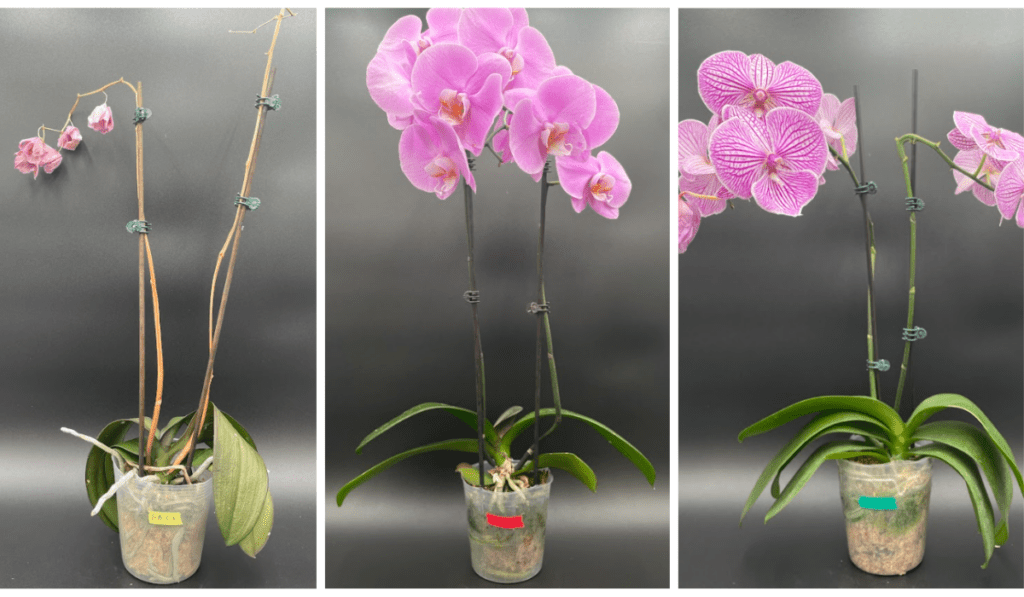
Challenge: Identify the substrate best suited for the consumer orchid market that would result in increased customer satisfaction Solution: Orchids grown in moss were on average 97 per cent larger compared to those grown in bark Impact: Business has increased to promote their research-backed substrate product lines and expects increased revenue customer satisfaction expected to increase with the product with enhanced care procedures
Orchids have become a staple in indoor floral decorating. You can easily spice up a room with a beautiful potted orchid and orchids continue to increase in popularity across North America with market demand and production of potted orchids doubling in between 2016 and 2020. While orchids are commonly grown in bark-based substrates, New Pao Tau Enterprises Inc. (New Pao Tau) is taking an innovative approach by using newer substrates with better water holding and release capacity than the typical bark-based substrates.
New Pao Tau grows a large selection of Phalaenopsis, Cattleya, Oncidiums and Paphiopedilums at their newly opened, state-of-the-art facility on a five-acre parcel of land in Beamsville, Ontario. To stay competitive, Michael Pang, Owner of New Pao Tao, realized he was going to need research to help his products stand out. With a new greenhouse in the Niagara neighborhood, Michael was familiar with Vineland Research & Innovation Centre (Vineland) and reached out to see what opportunities were possible.
As a member of the Greenhouse Technology Network (GTN), the Vineland Research and Innovation Centre was able to take on this research project to help Michael and the New Pao Tau team identify the substrate best suited for the consumer market and find a solution that would result in increased customer satisfaction.
In Vineland’s newly constructed Plant Lab in the Jordan Building, researchers conducted an indoor research trial evaluating shelf life of orchids grown in moss versus bark-based substrates at three blooming stages (100, 50 and 0 per cent) with three levels of irrigation (none, light, and optimal) to understand parameters such as leaf thickness, number of buds/flowers, chlorophyll content, and overall structure of the plant.
Results suggested that the water retention abilities of moss have significant impacts on plant health, reflected above by leaf thickness. Even without irrigation, the moss-grown plants didn’t differ significantly in leaf thickness from plants grown in bark and their overall healthier appearance was more likely to make them more appealing to the consumers.
At the end of the trial, the flowers grown in moss were on average 97 per cent larger compared to those grown in bark, which is associated with the available water content of the substrate.
“For the consumer, orchids are a difficult plant to care for. Ensuring that the orchids are grown in the best material and have the best care instructions is critical for their longevity. Understanding if there are new technologies which can improve plant health is an innovative way to support the industry,” said Nicole De Long, Director, Business and Client Development at Vineland.
The company now has the direction they need to move forward with the best substrate and care procedures for their customers to increase their satisfaction with the product and which will hopefully be reflected in their sales moving forward.
For Michael, he also hopes to take the information in the report from Vineland and expand on it putting a heavier emphasis on marketing.
“This was a very good report and now, we need to find ways to take the information we learned and share it with our customers in a digestible way, so marketing will be a focus moving forward for us,” he said.
With the new facility up and running in Beamsville, Michael indicated “…the first plants will be coming out from there in February, and after 20 years of hard work, we’ve finally gotten to the next level of producing orchids with this state-of-the-art greenhouse to bring even more products to our customers. The quality is there, we have the research now to back it up, and we are ready to promote New Pao Tau products to the marketplace.”
Visit the New Pao Tau website, or check them out on Instagram and Facebook.
This project was made possible by funding from the Federal Economic Development Agency for Southern Ontario, through the Niagara College-led Greenhouse Technology Network.
Visit Vineland Research and Innovation Centre’s website to learn more about its resources and capabilities.






